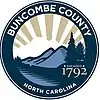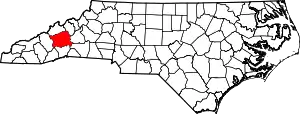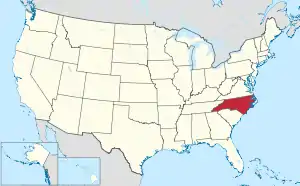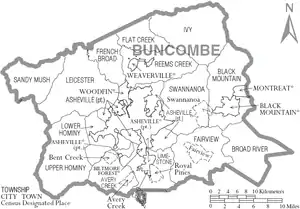Buncombe County, North Carolina
Buncombe County (/ˈbʌŋkəm/ BUNK-um)[1][2] is a county located in the U.S. state of North Carolina. It is classified within Western North Carolina. The 2020 census reported the population was 269,452.[3] Its county seat is Asheville.[4] Buncombe County is part of the Asheville, NC Metropolitan Statistical Area.
Buncombe County | |
|---|---|
.jpg.webp) Buncombe County Courthouse in Asheville | |
 Flag  Seal  Logo | |
| Motto: "People To Match Our Mountains" | |
 Location within the U.S. state of North Carolina | |
 North Carolina's location within the U.S. | |
| Coordinates: 35°37′N 82°32′W | |
| Country | |
| State | |
| Founded | 1792 |
| Named for | Edward Buncombe |
| Seat | Asheville |
| Largest community | Asheville |
| Area | |
| • Total | 659.95 sq mi (1,709.3 km2) |
| • Land | 656.50 sq mi (1,700.3 km2) |
| • Water | 3.45 sq mi (8.9 km2) 0.52% |
| Population (2020) | |
| • Total | 269,452 |
| • Estimate (2022) | 273,589 |
| • Density | 410.37/sq mi (158.44/km2) |
| Time zone | UTC−5 (Eastern) |
| • Summer (DST) | UTC−4 (EDT) |
| Congressional district | 11th |
| Website | www |
History
In December 1792 and April 1793, John Dillard was a Commissioner in a local political dispute of determining where the county seat of Buncombe County should be located. It was provided in an act creating Buncombe County for a committee of five persons to be appointed for the selection of the site. A dispute arose between two factions of Buncombe County residents on opposite sides of the Swannanoa River, one faction pressing for the county seat to be north of Swannanoa, which is now the center of Asheville, and the other faction demanding it to be at a place south of Swannanoa River, which later became known as the "Steam Saw Mill Place" and is now the southern part of the City of Asheville.
Buncombe County was organized by European Americans after the American Revolutionary War in the home of Colonel William Davidson, a cousin of William Lee Davidson who was elected as the county's first state senator.[5] The first meeting of the county government took place in April 1792 in Colonel Davidson's barn (located on the present-day Biltmore Estate).[6]
At first, deeds were recorded in Morganton, the nearest county seat. That was inconvenient for residents as roads were poor. In December 1792, seven men met to select a courthouse location for the county. The first courthouse was built at the present-day Pack Square site in Asheville.[7]
The county was formed in 1791 from parts of Burke and Rutherford counties. It was named for Edward Buncombe, a colonel in the American Revolutionary War who was captured at the Battle of Germantown.[8][9] The large county originally extended to the Tennessee line.
Many of the early settlers were Baptists. In 1807 the pastors of six churches, including the revivalist Sion Blythe, formed the French Broad Association of Baptist churches in the area.[10]
As population increased in this part of the state, parts of the county were taken to organize new counties. In 1808 the western part of Buncombe County became Haywood County. In 1833 parts of Burke and Buncombe counties were combined to form Yancey County. In 1838 the southern part of what was left of Buncombe County became Henderson County. In 1851 parts of Buncombe and Yancey counties were combined to form Madison County. Finally, in 1925 the Broad River township of McDowell County was transferred to Buncombe County.
In 1820, a U.S. Congressman whose district included Buncombe County, unintentionally contributed a word to the English language. In the Sixteenth Congress, after lengthy debate on the Missouri Compromise, members of the House called for an immediate vote on that important question. Felix Walker rose to address his colleagues, insisting that his constituents expected him to make a speech "for Buncombe." It was later remarked that Walker's untimely and irrelevant oration was not just for Buncombe—it "was Buncombe." Buncombe, afterwards spelled bunkum and later shortened to bunk, became a term for empty, nonsensical talk.[11] That, in turn, is the etymology of the verb debunk.
Geography
According to the U.S. Census Bureau, Buncombe county has a total area of 659.95 square miles (1,709.3 km2), of which 656.50 square miles (1,700.3 km2) is land and 3.45 square miles (8.9 km2) (0.52%) is water.[12]
The French Broad River enters the county at its border with Henderson County to the south and flows north into Madison County. The source of the Swannanoa River, which joins the French Broad River in Asheville, is in northeast Buncombe County near Mount Mitchell, a part of the Black Mountains range. Mt. Mitchell is the highest point in the eastern United States at 6,684 ft.[13] Its summit lies in adjacent Yancey County; the highest point in Buncombe County is Potato Knob, at 6400+ feet, which lies a short distance south of Mount Mitchell.
A milestone was achieved in 2003 when Interstate 26, still called Future I-26 in northern Buncombe County, was extended from Mars Hill (north of Asheville) to Johnson City, Tennessee. This completed a 20-year, half-billion dollar construction project through the Blue Ridge Mountains.
National protected areas
- Blue Ridge Parkway (part)
- Craggy Gardens
- Pisgah National Forest (part)
- Mount Pisgah (part)
- Nantahala National Forest (part)
State and local protected areas/sites
- Asheville Watershed[14]
- Beaver Lake Bird Sanctuary
- Big Ivy Historical Park
- Biltmore Estate
- Chimney Rock State Park (part)
- Collier Cove Nature Preserve
- The North Carolina Arboretum
- Pisgah National Forest Game Land (part)[15]
- Pisgah View State Park (part)
- Sandy Mush Game Land (part)[15]
- Thomas Wolfe House
- Vance Birthplace
- Western North Carolina Nature Center
- Young Forest
Major water bodies
- Beaver Lake
- Beaverdam Creek
- Broad River
- Burnett Reservoir
- Cane Creek
- Flat Creek
- French Broad River
- Lake Julian[16]
- Lake Kenilworth
- Lake Craig
- Lake Powhatan
- Lake Louise
- Left Fork Swannanoa River
- Little Pole Creek
- Long Valley Lake
- Newfound Creek
- North Fork Reservoir[14]
- North Fork Swannanoa River
- Pole Creek
- Reems Creek
- Right Fork Swannanoa River
- Swannanoa River
- Tom Creek
- Turkey Creek
Adjacent counties
- Madison County – north
- Yancey County – northeast
- McDowell County – east
- Rutherford County – southeast
- Henderson County – south
- Transylvania County – southwest
- Haywood County – west
Major highways
Major infrastructure
Demographics
| Census | Pop. | Note | %± |
|---|---|---|---|
| 1800 | 5,812 | — | |
| 1810 | 9,277 | 59.6% | |
| 1820 | 10,542 | 13.6% | |
| 1830 | 16,281 | 54.4% | |
| 1840 | 10,084 | −38.1% | |
| 1850 | 13,425 | 33.1% | |
| 1860 | 12,654 | −5.7% | |
| 1870 | 15,412 | 21.8% | |
| 1880 | 21,909 | 42.2% | |
| 1890 | 35,266 | 61.0% | |
| 1900 | 44,288 | 25.6% | |
| 1910 | 49,798 | 12.4% | |
| 1920 | 64,148 | 28.8% | |
| 1930 | 97,937 | 52.7% | |
| 1940 | 108,755 | 11.0% | |
| 1950 | 124,403 | 14.4% | |
| 1960 | 130,074 | 4.6% | |
| 1970 | 145,056 | 11.5% | |
| 1980 | 160,934 | 10.9% | |
| 1990 | 174,821 | 8.6% | |
| 2000 | 206,330 | 18.0% | |
| 2010 | 238,318 | 15.5% | |
| 2020 | 269,452 | 13.1% | |
| 2022 (est.) | 273,589 | [3] | 1.5% |
| U.S. Decennial Census[17] 1790–1960[18] 1900–1990[19] 1990–2000[20] 2010[21] 2020[3] | |||
Since 1970, the county has had a steady rise in population, attracting retirees, second-home buyers and others from outside the region.
2020 census
| Race | Number | Percentage |
|---|---|---|
| White (non-Hispanic) | 214,862 | 79.74% |
| Black or African American (non-Hispanic) | 15,017 | 5.57% |
| Native American | 727 | 0.27% |
| Asian | 3,274 | 1.22% |
| Pacific Islander | 467 | 0.17% |
| Other/Mixed | 13,183 | 4.89% |
| Hispanic or Latino | 21,922 | 8.14% |
As of the 2020 census, there were 269,452 people, 106,741 households, and 63,675 families residing in the county.
2000 census
At the 2000 census,[23] there were 206,330 people, 85,776 households, and 55,668 families residing in the county. The population density was 314 people per square mile (121 people/km2). There were 93,973 housing units at an average density of 143 units per square mile (55 units/km2). The racial makeup of the county was 89.06% White, 7.48% Black or African American, 0.39% Native American, 0.66% Asian, 0.04% Pacific Islander, 1.15% from other races, and 1.23% from two or more races. 2.78% of the population were Hispanic or Latino of any race.
There were 85,776 households, out of which 27.50% had children under the age of 18 living with them, 50.50% were married couples living together, 10.80% had a female householder with no husband present, and 35.10% were non-families. Of all households 28.90% were made up of individuals, and 10.60% had someone living alone who was 65 years of age or older. The average household size was 2.33 and the average family size was 2.86.
In the county, the population was spread out, with 21.90% under the age of 18, 8.60% from 18 to 24, 29.30% from 25 to 44, 24.80% from 45 to 64, and 15.40% who were 65 years of age or older. The median age was 39 years. For every 100 females there were 92.30 males. For every 100 females age 18 and over, there were 88.90 males.
The median income for a household in the county was $36,666, and the median income for a family was $45,011. Males had a median income of $30,705 versus $23,870 for females. The per capita income for the county was $20,384. About 7.80% of families and 11.40% of the population were below the poverty line, including 15.30% of those under age 18 and 9.80% of those age 65 or over. From 2010 to 2020 Buncombe County added 31,104 people or 13.0% population growth, making it the fastest growing county in Western North Carolina during the decade.
Law, government, and politics
Local government
Buncombe County is a member of the Land-of-Sky Regional Council of governments.
Buncombe County has a council/manager form of government. Current commissioners were elected in 2020: Chair Brownie Newman, Al Whitesides, Terri Wells, Jasmine Beach-Ferrara, Amanda Edwards, Parker Sloan and Robert Pressley.[24] The county manager is Avril Pinder.[25]
The North Carolina Department of Juvenile Justice and Delinquency Prevention formerly operated the Swannanoa Valley Youth Development Center in Swannanoa for delinquent boys, including those without sufficient English fluency. It opened in 1961.[26]
In 2019 former Buncombe County Manager Wanda Greene pleaded guilty alongside three former Buncombe County Government employees, and a county government contractor pleaded guilty to embezzling hundreds of thousands of dollars of public funds, accepting bribes, insurance fraud, and federal program fraud. Greene was sentenced to 84 months in prison.[27]
There are two public school systems within Buncombe County, including Buncombe County Schools and Asheville City Schools as well as many private schools and charter schools. There are four colleges in Buncombe County, including Asheville-Buncombe Technical Community College, University of North Carolina at Asheville, Montreat College, and Warren Wilson College.
Sheriff's Office and policing
The Buncombe County Sheriff provides court protection and jail administration for the entire county and provides patrol and detective services for the unincorporated areas of the county. The Sheriff's Office is organized into five divisions: Enforcement, Detention, Animal Control, Support Operations, School Resources, Civil Process.[28] The current Sheriff is Quentin Miller who was elected in 2018.[29] Asheville has a municipal police department, with David Zack named as the Chief of Police in 2020.[30] The municipalities of Black Mountain, Biltmore Forest, Montreat, Weaverville, and Woodfin also have municipal police departments, and UNC Asheville and Montreat College have campus police departments. The NC State Highway Patrol Troop G regional headquarters is located in east Asheville.[31]
State politics
As of 2023, in the North Carolina Senate, Julie Mayfield (D-49th) and Warren Daniel (R-46th) both represent parts of Buncombe County. Mayfield represents most of the county including Asheville and the west side. Daniel represents a portion of the east side of the county as well as McDowell and Burke Counties.
In the North Carolina House of Representatives, Eric Ager (D-114th), Lindsey Prather (D-115th), and Caleb Rudow (D-116th) each represent part of the county.
Federal politics
Buncombe had long been a bellwether county in presidential elections. It voted for the winning candidate in every election from 1928 to 2012, except for that of 1960.
Since 2008, the county has trended strongly toward the Democratic Party. It swung from a 0.6 point win for George W. Bush to a 14-point win for Barack Obama in 2008, and has gone Democratic by double-digit margins at every election since then. This includes 2016, when it voted for Hillary Clinton. When Donald Trump won the electoral college (and the election) after losing the popular vote, the county lost its bellwether status. In 2020, Joe Biden's performance in the county was the best by a Democrat since Lyndon Johnson's 1964 landslide.
North Carolina is represented in the United States Senate by Republicans Ted Budd and Thom Tillis, from Winston-Salem and Greensboro, respectively. All of the county is located in North Carolina's 11th congressional district, which is currently held by Republican Chuck Edwards.
| Year | Republican | Democratic | Third party | |||
|---|---|---|---|---|---|---|
| No. | % | No. | % | No. | % | |
| 2020 | 62,412 | 38.63% | 96,515 | 59.74% | 2,642 | 1.64% |
| 2016 | 55,716 | 40.10% | 75,452 | 54.30% | 7,779 | 5.60% |
| 2012 | 54,701 | 42.84% | 70,625 | 55.31% | 2,370 | 1.86% |
| 2008 | 52,494 | 42.40% | 69,716 | 56.32% | 1,585 | 1.28% |
| 2004 | 52,491 | 49.99% | 51,868 | 49.39% | 654 | 0.62% |
| 2000 | 46,101 | 53.93% | 38,545 | 45.09% | 830 | 0.97% |
| 1996 | 30,518 | 44.19% | 31,658 | 45.84% | 6,891 | 9.98% |
| 1992 | 30,892 | 40.92% | 32,955 | 43.65% | 11,645 | 15.43% |
| 1988 | 36,828 | 57.55% | 26,964 | 42.14% | 200 | 0.31% |
| 1984 | 37,698 | 61.62% | 23,337 | 38.14% | 148 | 0.24% |
| 1980 | 26,124 | 48.80% | 24,837 | 46.40% | 2,569 | 4.80% |
| 1976 | 22,461 | 45.49% | 26,633 | 53.94% | 285 | 0.58% |
| 1972 | 32,091 | 70.38% | 12,626 | 27.69% | 877 | 1.92% |
| 1968 | 21,031 | 44.23% | 14,624 | 30.76% | 11,889 | 25.01% |
| 1964 | 19,372 | 37.99% | 31,623 | 62.01% | 0 | 0.00% |
| 1960 | 28,040 | 54.61% | 23,303 | 45.39% | 0 | 0.00% |
| 1956 | 22,655 | 54.33% | 19,044 | 45.67% | 0 | 0.00% |
| 1952 | 24,444 | 52.15% | 22,425 | 47.85% | 0 | 0.00% |
| 1948 | 11,460 | 37.15% | 17,072 | 55.34% | 2,319 | 7.52% |
| 1944 | 9,398 | 31.04% | 20,878 | 68.96% | 0 | 0.00% |
| 1940 | 8,723 | 25.96% | 24,878 | 74.04% | 0 | 0.00% |
| 1936 | 9,470 | 28.60% | 23,646 | 71.40% | 0 | 0.00% |
| 1932 | 8,745 | 31.97% | 18,241 | 66.69% | 367 | 1.34% |
| 1928 | 16,590 | 57.22% | 12,405 | 42.78% | 0 | 0.00% |
| 1924 | 6,285 | 37.30% | 10,098 | 59.93% | 467 | 2.77% |
| 1920 | 8,017 | 44.09% | 10,167 | 55.91% | 0 | 0.00% |
| 1916 | 3,830 | 47.52% | 4,229 | 52.48% | 0 | 0.00% |
| 1912 | 426 | 6.53% | 3,716 | 56.92% | 2,386 | 36.55% |
| 1908 | 3,572 | 50.03% | 3,506 | 49.10% | 62 | 0.87% |
| 1904 | 2,591 | 44.70% | 3,181 | 54.88% | 24 | 0.41% |
| 1900 | 4,140 | 52.41% | 3,724 | 47.15% | 35 | 0.44% |
| 1896 | 4,611 | 52.80% | 4,098 | 46.93% | 24 | 0.27% |
| 1892 | 3,125 | 44.18% | 3,588 | 50.73% | 360 | 5.09% |
| 1888 | 2,873 | 48.29% | 2,956 | 49.68% | 121 | 2.03% |
| 1884 | 2,007 | 42.87% | 2,649 | 56.58% | 26 | 0.56% |
| 1880 | 1,591 | 44.37% | 1,995 | 55.63% | 0 | 0.00% |
Public libraries
Buncombe County Public Libraries has 11 branch locations, with a central location at Pack Memorial Library in downtown Asheville.[33]
Communities

City
- Asheville (county seat and largest community)
Townships
- Asheville
- Avery Creek
- Black Mountain
- Broad River
- Fairview
- Flat Creek
- French Broad
- Hazel [34]
- Ivy
- Leicester
- Limestone
- Lower Hominy
- Reems Creek
- Sandy Mush
- Swannanoa
- Woodfin
- Upper Hominy
Census-designated places
Unincorporated communities
- Alexander
- Arden
- Beaverdam
- Candler
- Coburn
- Enka
- Flat Creek
- Forks of Ivy
- Jupiter
- Leicester
- Oak Park
- Ridgecrest
- Sandymush
- Skyland
- Stocksville
- Wilson
See also
References
- "NC Pronunciation Guide". WRAL. Retrieved August 16, 2023.
- Talk Like a Tarheel Archived 2013-06-22 at the Wayback Machine, from the North Carolina Collection website at the University of North Carolina at Chapel Hill. Retrieved 2023-08-16.
- "U.S. Census Bureau QuickFacts: Buncombe County, North Carolina". United States Census Bureau. Retrieved May 31, 2022.
- "Find a County". National Association of Counties. Archived from the original on May 31, 2011. Retrieved June 7, 2011.
- "William Davidson Confusion Continues". November 17, 2014. Retrieved November 8, 2018.
- Neufeld, Rob (August 18, 2019). "Visiting Our Past: Roads, orphans, speculation and missing ears occupied first settlers". Asheville Citizen-Times. Retrieved August 18, 2019.
- Neufeld, Rob (August 11, 2019). "Visiting Our Past: Alcohol drinking helped Asheville planners in 1792". Asheville Citizen-Times. Retrieved August 11, 2019.
- J.D. Lewis. NC Patriots 1775–1783: Their Own Words, Volume 1. JD Lewis. pp. 54–. ISBN 978-1-4675-4808-3.
- Best Books on (1939). North Carolina, a Guide to the Old North State. Best Books on. pp. 496–. ISBN 978-1-62376-032-8.
- David Benedict (1813). "NORTH-CAROLINA". A GENERAL HISTORY OF THE BAPTIST DENOMINATION IN AMERICA, AND OTHER PARTS OF THE WORLD. Lincoln & Edmands. Retrieved August 29, 2010.
- debunk – The American Heritage Dictionary of the English Language: Fourth Edition. 2000 Archived April 6, 2008, at the Wayback Machine, Houghton Mifflin, Boston, accessed 2009-01-11
- "2020 County Gazetteer Files – North Carolina". United States Census Bureau. August 23, 2022. Retrieved September 9, 2023.
- http://www.ncparks.gov › mount-mitchell-state-park
- "Asheville Watershed". www.nps.gov. September 30, 2020. Retrieved August 21, 2023.
- "NCWRC Game Lands". www.ncpaws.org. Retrieved March 30, 2023.
- "Lake Julian Park: Picnicking, Canoeing, Family Fun, Boat Rentals, Boat Storage, Walking Trails, Festival of Lights - Buncombe County Recreation Services | Asheville". www.buncombecounty.org. Retrieved December 20, 2021.
- "U.S. Decennial Census". United States Census Bureau. Retrieved January 12, 2015.
- "Historical Census Browser". University of Virginia Library. Retrieved January 12, 2015.
- Forstall, Richard L., ed. (March 27, 1995). "Population of Counties by Decennial Census: 1900 to 1990". United States Census Bureau. Retrieved January 12, 2015.
- "Census 2000 PHC-T-4. Ranking Tables for Counties: 1990 and 2000" (PDF). United States Census Bureau. April 2, 2001. Archived (PDF) from the original on March 27, 2010. Retrieved January 12, 2015.
- "State & County QuickFacts". United States Census Bureau. Archived from the original on July 13, 2011. Retrieved October 17, 2013.
- "Explore Census Data". data.census.gov. Retrieved December 19, 2021.
- "U.S. Census website". United States Census Bureau. Retrieved January 31, 2008.
- "County Commissioners". Buncombe County Government. Buncombe County Government. Retrieved February 14, 2021.
- "county-organizational-updates-July22" (PDF). www.buncombecounty.org. August 30, 2022. Archived (PDF) from the original on January 30, 2019. Retrieved August 30, 2022.
- "Swannanoa Valley YDC" (). North Carolina Department of Juvenile Justice and Delinquency Prevention. April 28, 2006. Retrieved on December 16, 2015.
- "Former Buncombe County Manager, Three Former County Employees, And A County Contractor Are Sentenced To Prison For Embezzling Public Funds". United States Department of Justice. United States Department of Justice. Retrieved February 14, 2021.
- Sheriff's Office - Buncombe County | Asheville
- DeGrave, Sam. "Miller makes history with resounding victory in sheriff election". The Asheville Citizen Times. Retrieved August 31, 2022.
- avladmin. "Police". The City of Asheville. Retrieved August 31, 2022.
- "Police Departments - Buncombe County, NC (Arrest Records & Police Logs)". www.countyoffice.org. Retrieved August 21, 2023.
- Leip, David. "Dave Leip's Atlas of U.S. Presidential Elections". uselectionatlas.org. Retrieved March 14, 2018.
- "Libraries - Branch Locations". www.buncombecounty.org. Retrieved November 25, 2019.
- though not listed on the census map below, it shows up here: https://www.buncombecounty.org/common/landRecords/mappers_townships.pdf
External links
 Geographic data related to Buncombe County, North Carolina at OpenStreetMap
Geographic data related to Buncombe County, North Carolina at OpenStreetMap- Official website
- NCGenWeb Buncombe County, genealogy resources for the county
